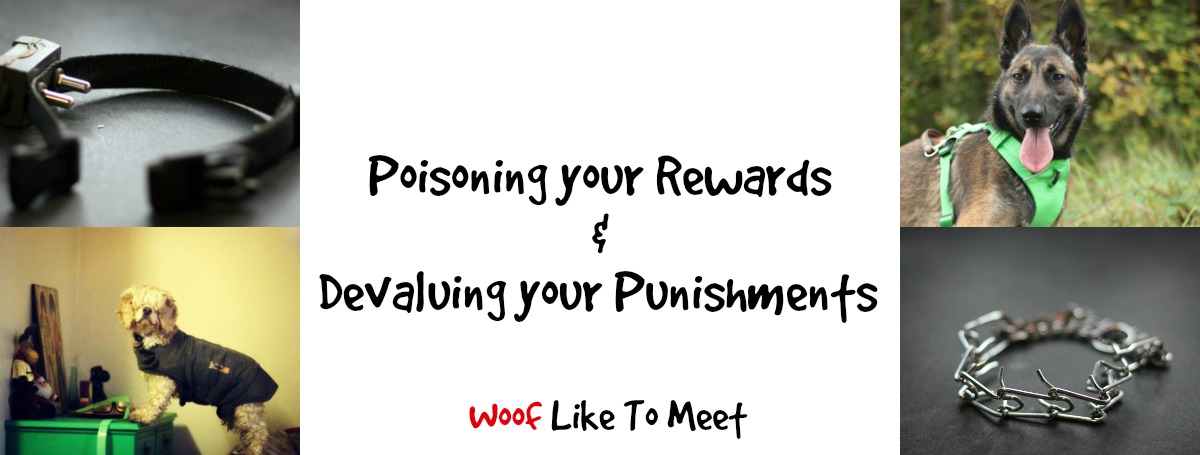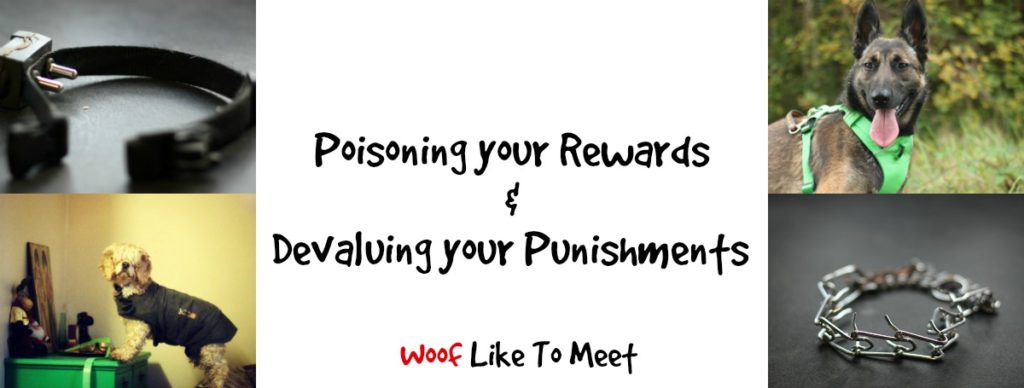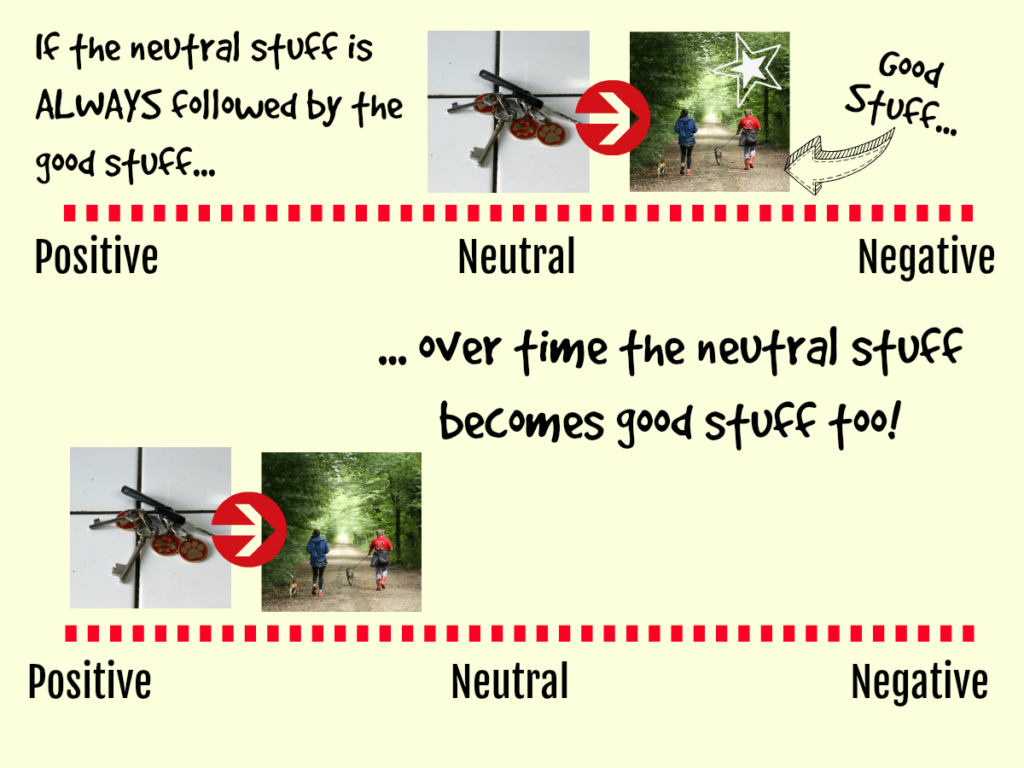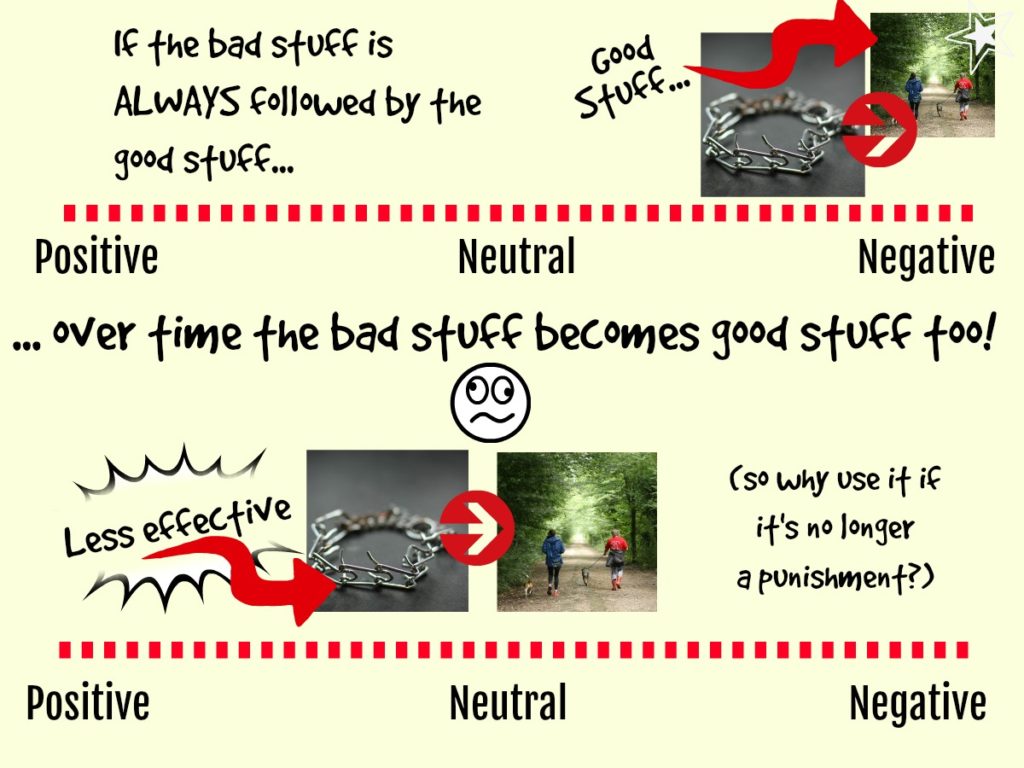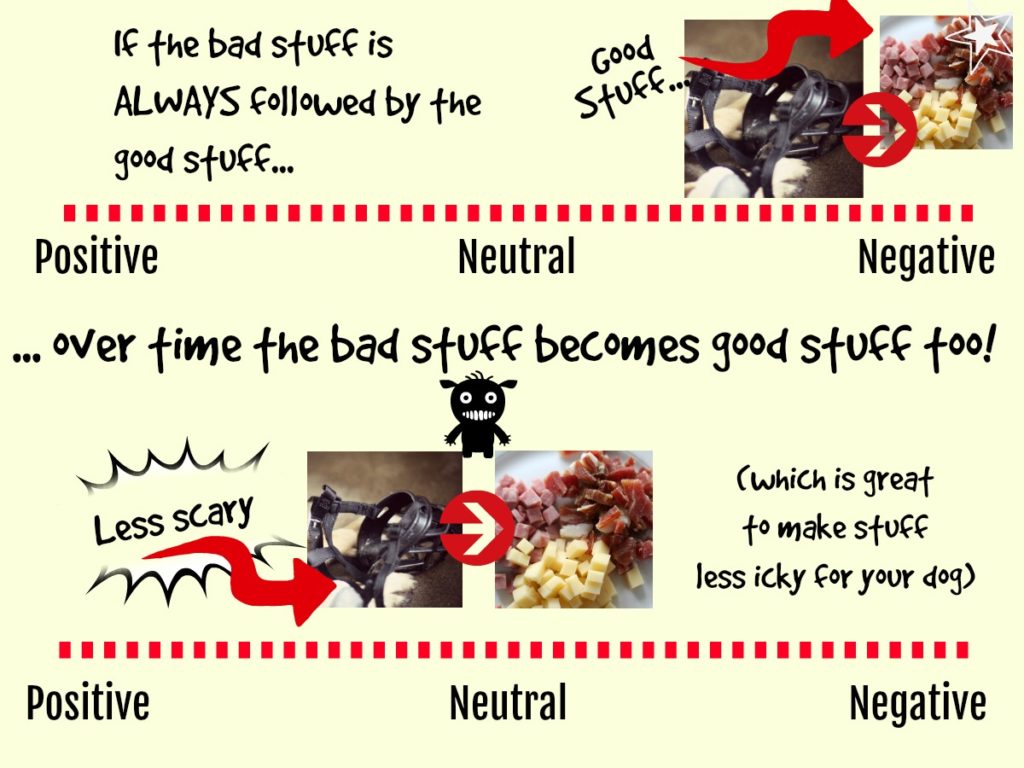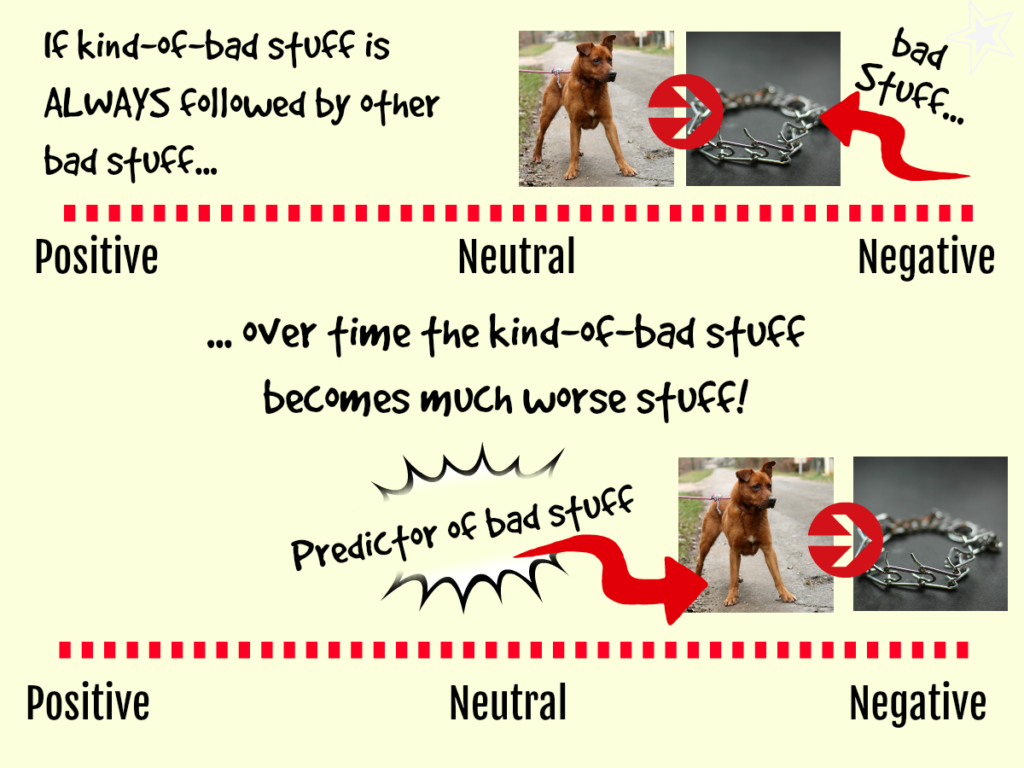A couple of weeks ago, I was looking at why order is so important in Dog Good Stuff and Dog Bad Stuff.
Seeing a few posts on Facebook reminded me why I needed to do the follow-up post about common training mistakes.
The first was a video of a ‘balanced’ dog trainer showing his dog walking with a muzzle on and finishing with a game of tug. I was laughing because this guy likes to sell himself as tough, the Alpha of his dogs, and there he is using positive reinforcement and a conditioned pairing. Also, using flooding, since the dog was clearly uncomfortable in the muzzle, but hey. Nothing the trainer would have found quite so offensive as being thought of as a positive trainer! Clear case of Dog Bad Stuff followed by Dog Good Stuff meaning the power of the Bad Stuff is not quite so BAD!
The second was a post about a bin-dipping GWP. The owner had been using something called ‘training discs’ (which sounds like another word for dog frisbees but sadly is just a bunch of some horrible noisy little cymbal-type things) and was disappointed because they weren’t working. Clear case of Dog Bad Stuff (noisy metal things supposed to discourage behaviours) followed by Dog Good Stuff (ill-gotten trash). Once again, the Bad Stuff was not quite so BAD (and the dog was photographed in amidst its ill-gotten gains) because it was followed by some major good stuff. The post unravels with various suggestions of other Dog Bad Stuff which are equally doomed to failure, including using mouse-traps, duct tape and pans. There are lots of people saying ‘put your bin away’ too, which gave me some hope for humanity. One person said they should rent their puppy out to potential owners. Now there’s a pairing! Human Good Stuff (cute puppies!) followed by Human Bad Stuff (constant vigilance and cleaning up) which I thought was funny. There’s nothing like a bin-obsessed puppy to take the edge off the ‘Awwww, puppies!’ feeling.
The third post was one sharing the despair of a good trainer that her client had sought out the ‘superior knowledge’ of Facebook for a Magic Bullet for a behavioural complaint and had a long list of painful ways to stop a behaviour that would be doomed to failure too.
And the fourth was a ‘cute’ video of a weeks-old Mali puppy who was not deterred in the slightest from biting her owner, who was telling her off and yelling ‘no!’, trying to shake her off and yelping. Mixed up Dog Good Stuff and Dog Bad Stuff = devalued, meaningless punishers.
As I explained in the previous post, I’m substituting the term Good Stuff for ‘reinforcers’ because it’s just less jargony. Good stuff includes all manner of sensory and behavioural rewards that we might consider icky or annoying, as well as those we’d traditionally think of as good. Dog Good Stuff runs the gamut from rolling in festering wild boar diarrhea (which will pull my cocker from a heel to go and find it, wherever it is) to beef treats. It includes games such as tug, chase, hide-and-seek and fetch, tapping into their natural canine behaviours like searching, chasing, biting and dissecting. It includes behaviours such as moving forwards on a walk, seeking, licking, jumping or barking. Whilst we might give our dogs a lot of Good Stuff, some of that comes from within. Heston, for instance, my Groenendael X, loves nothing more than the sound of his own voice. Like his owner, no doubt. He has such joy in a fanfare of barks, a volley of vibrant shouting. In fact, when one of my friends died recently, and we had a very windy day, I walked Heston to the top of a nearby hill and did a bit of yelling into the wind. Heston looked at me with a look that can only have said, “Now, see how good THAT feels!”
Bad Stuff is things dogs don’t like or may have to be taught to like. That depends on your dog. For my pocket cocker, that is Baths, Haircuts, Nail Clipping, Eye cleaning, Ear cleaning… any kind of husbandry is offensive to her very spirit. What dogs don’t like depends on their experiences but many of those things don’t have to be taught. You don’t have to teach a dog to avoid pain, for instance. You don’t have to teach them to avoid shocks. If I drop an onion on the floor, even the greedy pocket cocker isn’t interested (though it’s different if cooked). Naturally aversive things are equally sensory – smells, tastes, sensations, noises and sights. Sight is a little bit different. I, for instance, think the thought of Naked Donald Trump to be very aversive. If you papered my bedroom with that image, I’d avoid it completely. I don’t think that works in the same way for dogs. That said, the sight of that blessed shouty terrier down the road is aversive to two of my dogs who try to avoid him. Likewise for me, the sight of a police car in my rear view mirror is enough to make me squirmish and evasive.
If you need to recap learning, have a look at this post.
Just to make it clear – I don’t choose to use Bad Stuff in my work. But I get many clients who come having devalued their Bad Stuff and want to know why:
a) spraying a dog in the face isn’t stopping it humping
b) using a citronella collar isn’t stopping them barking
c) why their dog hasn’t learned to walk to heel with a choke collar
d) why they’ve had to turn the bark collar up to full
e) why their very expensive ‘invisible’ electric fence isn’t working
f) why saying ‘no!’ and yanking on a dog’s collar isn’t making them less reactive
And so on.
I don’t think punishers work. I think it’s easier to hype up the value of a reward than it is to maintain the value of a punisher. I think the potential fallout of punishers is too much of a risk. And finally, there are no circumstances in which management or positive reinforcement hasn’t worked for me yet. But that’s not to say I’m advising you on how to keep a range of brutal, deeply unpleasant punishers valuable. In theory, the best way to keep them valuable is to barely use them at all. (I’d say never!) That way, you can keep something mildly aversive (what Ian Dunbar calls ‘ugly face’ or a ‘no!’) and keep the power of it because you use it so infrequently. Then you never need to use the ‘heavy artillery’ of shock, chokes or prongs. The worst thing about punishers is the more you use them, the more you need to use them.
Just so you are clear.
I’m all about turning the bad stuff in dogs’ lives into neutral stuff, or even good stuff.
So last time I was writing about how one of the worst things we can do is accidentally remove the power of the Good Stuff and the Bad Stuff that we can offer our dogs. And also how we can accidentally turn something neutral into something wonderful or something horrible. It’s all about pairings.
Dogs are good at working out the meaning of things when things happen in patterns. And they work out whether that’s a good pattern for them, or a bad one.
Keys >>>>> walk
Boots >>>>> walk
Keys >>>>> you going out and leaving me
Boots >>>>> you going out and leaving me
They are SO smart like that. Can you see how you can take something that is absolutely meaningless to a dog, like a key, and turn into an object that predicts Most Excellent Dog Stuff or Most Bogus Dog Stuff? We do this every day.
We also know that we can remove the power of something that is Most Bogus Dog Stuff… I don’t yell (much!) in the home. So when I stubbed my toe at 4am the other morning when I stumbled, sleep-deprived, out of bed to let out my dog with dementia for a pee… let’s just say all four dogs shot back to bed, including the dementia dog who half the time doesn’t seem to know where he really is. But when you pair yelling with Dog Good Stuff, as I’m doing at the moment to help prepare a young dog for his trials with customs officers, every time someone yells, that dog thinks it is a bonus predictor of a game of ball. Pairings are powerful ways to take the sting out of the bad stuff.
So we know that stuff works backwards.
If Good Stuff comes last, it makes the stuff before it into Good Stuff too. Things that had been meaningless like boots, cars and harnesses now become things that Spark Dog Joy.
If Bad Stuff comes last, it makes the stuff that comes before into Bad Stuff too. Things that had been meaningless like a vet’s room, a travel crate or a car now become things that Crush Dog Spirits.
So if we follow a prong pop (Bad) with continued walk (Good) the prong pop can become a signal that good stuff will happen.
If we follow a ‘Come on! Good Boy!’ for coming back (Good) with being put on the lead (Bad) then ‘Come on!’ can become a signal that bad stuff will happen.
And we use this all the time in counter-conditioning to teach dogs that a horrible, icky thing that they’ve had a bad experience with is not so bad after all…
It’s not so tough.
When neutral stuff is always followed (fairly immediately) by the same good stuff, it becomes good stuff too.
When bad stuff is always followed (fairly immediately) by the same good stuff, it becomes less bad and eventually might become good.
When good stuff is always followed (fairly immediately) by the same bad stuff, it steals the joy from the good stuff.
When neutral stuff is always followed (fairly immediately) by the same bad stuff, it turns the neutral stuff into a sign that bad stuff will happen.
But you want to know how that works in real life.
Today I’ve got ten unexpected pairings that probably won’t work as they mix up rewards and punishments. The first includes my cat, Basil, who taught me a very important message.
Problem #1: aversion to food
Tuna (Good) followed by Pill (Bad) = turning my cat off Cat Good Stuff.
Before I knew about this powerful crazy Pavlovian magic, I only ever broke out the tuna when I wanted to give my cat a pill. At first that worked. Tricked into eating the pill. Then it didn’t. He’d eat round the pill. Then I tried to force the pill down. You know how that went. Scratches, blood, angry cat. It takes a lot to ‘poison’ a primary reinforcer (things you don’t need to teach an animal to like) yet I managed it. Not only that, I managed to take the sound of the tin opener and turn it into a cue for Basil to hide somewhere unreachable. How to turn Cat Good Stuff into a great predictor of something that is Cat Bad Stuff in one fell swoop.
Solution: teach cats about lots of foods as a kitten (since palettes are hard to expand for cats), give tuna lots more so that it is no longer a 100% predictor of ‘The Horrible Pill Experience’, use lots of different foods so that no single food is a 100% predictor of a pill.
Problem #2: pulling despite physical pain
Leash corrections (Bad) followed by continued walk (Good) = making leash corrections pointless.
I see this all the time. People who walk the dog with a Pop-Pop-Pop on the collar. It is their primary reason for spewing that “Prongs/Chokes don’t hurt” crap. “It’s not working, therefore it can’t be painful.” No, they still hurt. You’ve just made it so that you have gradually desensitised your dog to the experience by pairing it always with a reward. In fact, I was smug about the Master Balanced trainer and his muzzle training because he had to pop his GSD five times in 30 seconds when the dog was ‘heeling’. In fact, I shouldn’t have been smug at all. But can you see how that goes? The more you pop, the more you’ll need to, if you pair it with continued Good Stuff. And the more intensity you’ll need. If your leash corrections aren’t working, why use them?
Solution: teach loose-leash walking. Don’t use Dog Bad Stuff on a walk because it will inevitably be followed by Good Stuff (the walk) so there’s no point.
Problem #3: Bin dipping despite noisy Training Discs placed on top
Crashing training discs (Bad) followed by Bin Treasure (Good) = making training discs a necessary nuisance before revelling in discarded trash
So why did those training discs work once or twice and then stop? Because once the noise is predictable – and it’s always predictable on your third or fourth try – if it’s not more aversive than the treasure is rewarding, it’ll stop working. That crash is a predictor that you have completed the challenge of getting to the trash and you can take home your delightful garbage reward to enjoy at your leisure.
Solution: put the bin away. Put safety locks on your cupboards. Be tidy and don’t be cross at a dog for scavenging. They are being very good at Dog Stuff as far as they are concerned, whereas you are being very bad at predicting Dog Stuff. The mess punishes YOU, so YOU need to learn from it – not the dog.
Problem #4: Counter surfing despite sticky tape or tin foil on surface
Sticky tape/tin foil (Bad) followed by Counter-foraged Chicken carcass/Birthday Cake (Good) = making unpleasant experiences a sign that there is something really good up there.
If your dog can get to Counter Swag, your aversive is just a predictable hurdle. If they manage to get the chicken carcass, it’s a hurdle worth overcoming. Don’t forget: jackpot learning, where there is a 1 in a 100 chance of Very Excellent Counter Swag, can be more powerful than 1 to 1 rewards. Tilly my cocker knows this. Last night, she swagged two diet crackers from the table. Do you think despite their disgusting inedible qualities that she will stop hopping onto the table in my absence? Hell no. I have lived with her 7 years and whilst she only gets swag once in a while, it’s more than enough to reinforce the habit.
Solution: Tidy up and restrict access to counters. If there is never anything good on the counter, there is no reason to think it might contain Dog Good Stuff and for your dog to be seeking out some kind of treasure. A dog who never does this behaviour never learns to. Ironic that my only dog who needs a chair to assist her is the only one who does it. Thank God my bigger dogs didn’t. When I had the handsome 45kg shelf-surfing Ralf and he used to get onto the kitchen shelves, I put stuff in sealed boxes.
Problem #5: Getting on the couch despite obstacle course
Obstacle course/falling chairs (Bad) placed on couch followed by 3 hours of lazy afternoon napping on DFS’s finest corduroy couch (Good)
Another one that isn’t technically a devalued punisher (like the one before) since it depends on the fact that you need your aversive to be more powerful than your reward. But if the reward is 3 hours of comfortable napping (or even fairly uncomfortable between the obstacles) then it takes the sting out of the punisher and devalues it. A clatter of falling chairs might be enough to scare the dog a handful of times, but if the incentive is big enough and the punisher is predictable enough, it’ll soon stop being a reason not to get on the couch. Then you’re left with another situation in which you need to up the level of punishment. Mouse-traps, anyone?
Solution: make sure your dog is never allowed on the couch and that they have a very comfy bed/couch of their own. Teach them to get on or off when asked. Or crate train them. Make sure they never learn that couches are for dogs. Take my dining room chairs, for example, my dogs don’t sit on those because they have never been invited to. Or, do as I have done today and foster a very stinky, menacing Yorkshire terrier and put him on the couch in question. Strangely, the couch that he is on is empty (except for him) and the dog beds are all full. Kidding, of course. If your dogs have learned that couches are comfortable, and you have aided and abetted that, be prepared to teach them on/off when asked and allow a bit of couch time, restrict their access to the couch and make their own bed so good that a couch seems redundant.
Problem #6: thinking Ape Good Stuff is Dog Good Stuff
A dog comes to you for contact (Good) and then patting it on the head (Bad)
It wasn’t until I went in for a ‘coochy-coo’ squishy cuddle with Tilly that I realised the lip-licking, the head-turning were evasive movements. She did not like that coochy-cooing. You can use this effectively for a dog who attention-seeks. Amigo, my senile old griffon dude likes to rest his head on my knee. The problem is that he does it ALL the time and he often comes in for it when I’m sitting with my other dogs who then think he isn’t respecting their boundaries which causes grumbles. I do two gentle pats to the head and he goes away. It’s amazing to think that something we think a dog should like – being touched – can be unpleasant enough to send a serial cuddle monster into a dog who goes away. And I’m talking the kind of ‘pat-pat’ that is so gentle most of us would think it a perfectly acceptable greeting for a dog. The trouble is that if your pet arrives for contact and you touch it – completely innocuously! – in what would be the most mild aversive, you may find your dog doesn’t approach you at all for petting.
Solution: teach your dog that petting is followed by good stuff, so that your ape-like neutral/negative handling becomes a positive by association. With Lidy, she likes licking my face, so I let her do that when she has had some Chimp Hugs from me. Those chimp hugs get the backwards buzz of the pleasure of licking as they are a 100% predictor that I will pucker up for a good snog with a toothy mali.
Problem #7: turning neutral stuff into nasty stuff.
Problems getting your dog into the bathroom (neutral) because you always give them a bath (Bad) or problems getting your dog to have its nails clipped (neutral) because you pinched them once (Bad) or turning your dog’s name (neutral/positive) into something bad by always telling them off when you use it. Whether it’s turning car journeys into a nightmare, baths into chaotic maulings, turning dog coats into a wrestling match, you can easily turn neutral stuff into nasty stuff.
Take their name for example.
Now under normal circumstances, if you give your dog the occasional name call to distract them, like I just did with Heston who decided to alarm bark at a lorry for no apparent reason, it’s not a big deal, unless it’s nearing a 1:1 ratio. Now mostly when I say “Heston!” it’s for good stuff. Probably not as frequently as I would think, but if the only time I ever said his name was to tell him off, then expecting it to get his attention and aid a recall is madness. One of my neighbours has a spaniel called Filou. He quite often yells at Filou to stop barking. It’s 100% likely that when he says ‘Filou!’ that it’s supposed to punish him for barking. Doesn’t work, because barking is its own reward and shouting a dog’s name is not enough to distract or punish, but also it’s a 100% prediction of worse stuff to come because Filou has a shock collar and my joyless neighbour gives him a zap with it. When he was trying to shout Filou back to the house an hour ago, do you think it worked?
Some people will tell you that you need to teach a new cue if you’ve poisoned an old one by turning it into Dog Bad Stuff, but that’s not necessary really. All you’ve got to do is break the association. If your dog thinks cheese means a pill, make cheese mean nothing by using it all the time. If you want Come! to regain its value, make it 100% followed by Amazing Dog Stuff once more. I think sometimes we forget the importance of ‘refreshing’ the association between a name and a consequence, or between ‘come!’ and a reward. A bit of a jackpot from time to time will make sure that habit doesn’t fall out of fashion.
The only time I’d advise changing a dog’s name, for instance, is in situations like poor Filou’s. That would take a lot of work to change it back to a positive thing again.
Solution: make sure that it’s not a 1:1 relationship between the neutral stuff and bad consequences. If you need to get your dog in the car for the vet, then you need to know that there is no way your dog can predict that cars = vets. If cars mean five other things, then that association is less likely to form. Better still is to get your dog into pairing the neutral stuff like bathrooms and cars with ‘good stuff’. Do you think you’d have a problem getting your dog into the shower if you fed them in the shower? I groom Tilly in the kitchen. I feed her in the kitchen. We do other things in the kitchen too (otherwise every time I went to the kitchen, she’d think I was going to feed her) but there is no way she could know that if she goes into the kitchen with me, she’s going to get groomed. She does know when the Cupboard of Doom opens, so I put her clippers in the Kong cupboard. Do you think it’s still the Cupboard of Doom? If you want to remove the association between an event and the thing that precedes it, do the thing that precedes it hundreds of times in hundreds of ways until it is absolutely and utterly meaningless. If the event produces a fear reaction, you may need to be careful how you do this, so that it is absolutely nothing horrible and you don’t accidentally flood your dog with horrible emotions, but if it’s just unpleasant, breaking the 1:1 relationship between the two is crucial
It’s not just about following good with bad or bad with good. It can also about how you can take a fairly unpleasant thing and intensify it with Bad Stuff or how you can take a good thing and intensify it with Good Stuff.
Problem #8: Aggression on lead
Seeing another dog (bad if you’re a dog-aggressive dog) and being told ‘No!’ or being popped/jerked/cranked or shocked (Bad +)
This just amps up the bad of the first bit, since it now predicts more bad stuff. If I don’t like Donald Trump, you pinching my ear every time I see him isn’t going to help. Remember too that it’s about that 1:1 relationship. If every time I see Donald Trump it becomes a predictor of an ear pinch, I’m going to end up dreading seeing him more than I already do. If every time my dog-aggressive dog jerks and lunges towards another dog and I pop her choke collar, it is a 100% predictor of some major Bad Stuff happening.
Problem #9: not being able to solve a jumping-up problem
Jumping up (Good) and getting attention by being told off (person thinks it is Bad Dog Stuff, dog thinks it is Good Dog Stuff)
What you are essentially doing here is reinforcing a behaviour that the dog likes doing already. If you join in and shout at them when they bark, then you’re reinforcing the barking. If you have a dog who is doing something perfectly doggie (humping, mouthing, chewing) attention for doing it, you’re reinforcing the behaviour. If you laugh at a humper, you’re more likely to see that behaviour again. If you give attention to a dog who is barking to get your attention, if you pet a dog who nudges you to get attention, you’re heaping good on already good behaviours and you’ll find them hard to break.
Solution: give zero reinforcement for jumping up, teach an alternative behaviour that you can’t do at the same times as jumping up (like a sit or a down-stay) and only reward that.
Problem #10 Accidentally turning a neutral thing like a thunder shirt into a predictor of Bad Stuff.
Amigo doesn’t have very peaceful nights anymore. That’s especially true if there’s a storm or high winds. I put a thunder shirt on him and give him herbal remedies when a storm is forecast. The thunder shirt and the pills become a very good predictor of a storm and make him more anxious not less.
Solution: use thunder shirts and give herbal remedies plenty of other times as well so that it is no longer a reliable predictor of storms.
The same is true of all anti-anxiety things you do with your dog. If you only do them when you can predict your dog will be in an anxious situation, as soon as you reach for the thunder shirt or you stick on the calming music, you are giving your dog a 100% 1:1 predictor that a storm is coming. Or, do it long enough before the storm so that there is no connection between the two events in the dog’s mind. That doesn’t have to be massively long.
So, there you have it… ways that Pavlov can massively interfere with your animal’s life and training, and some quick ideas of how to avoid some common pitfalls.

